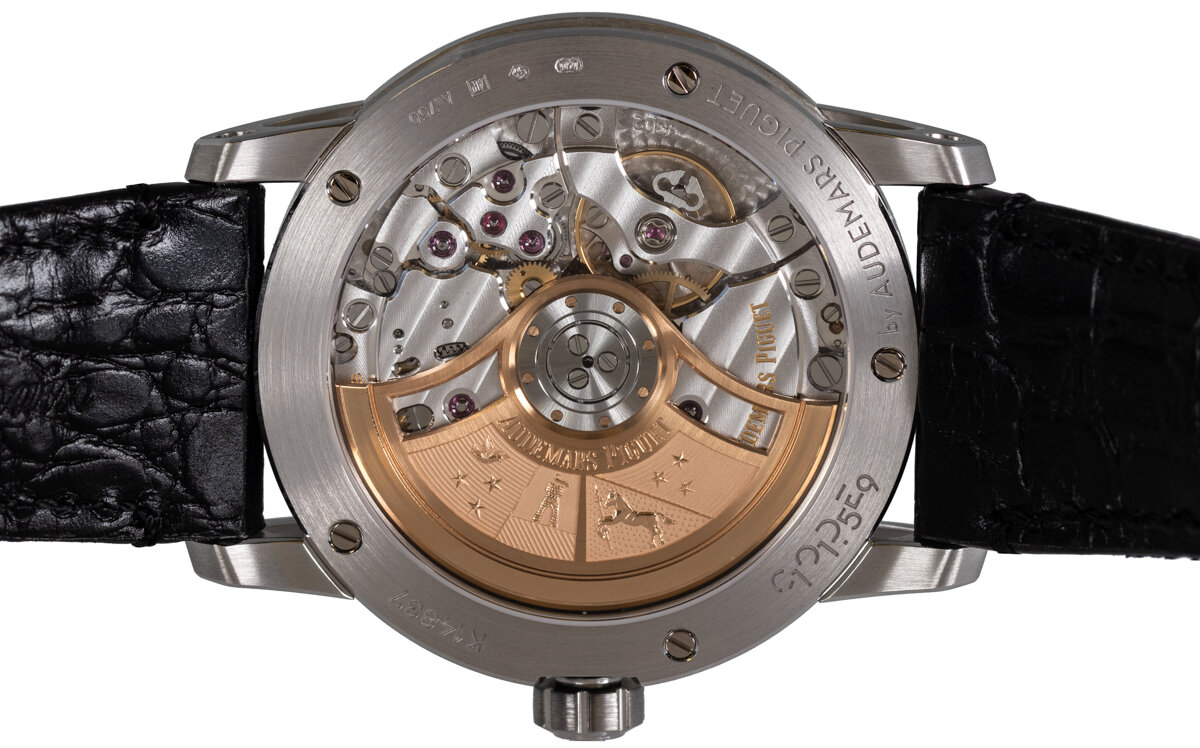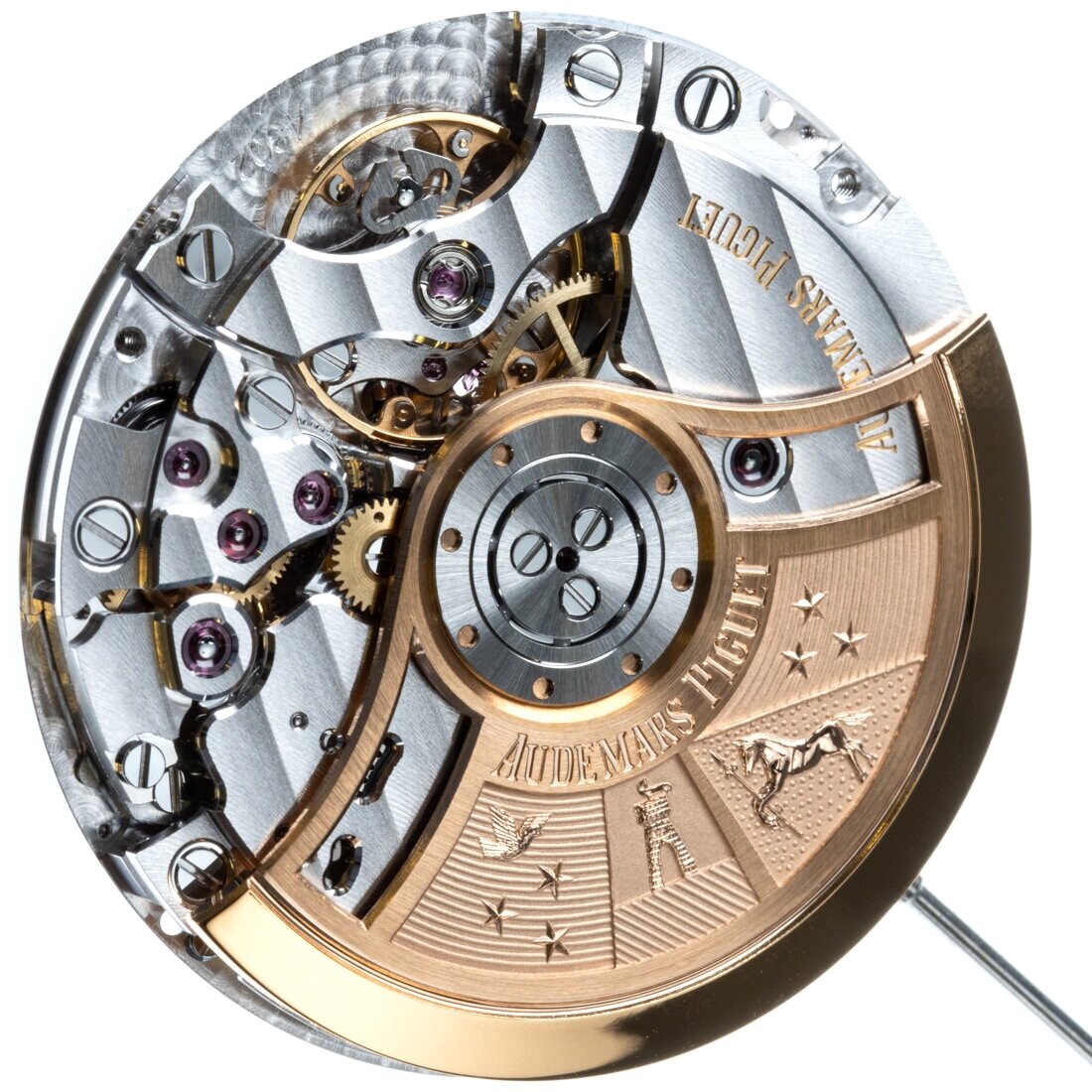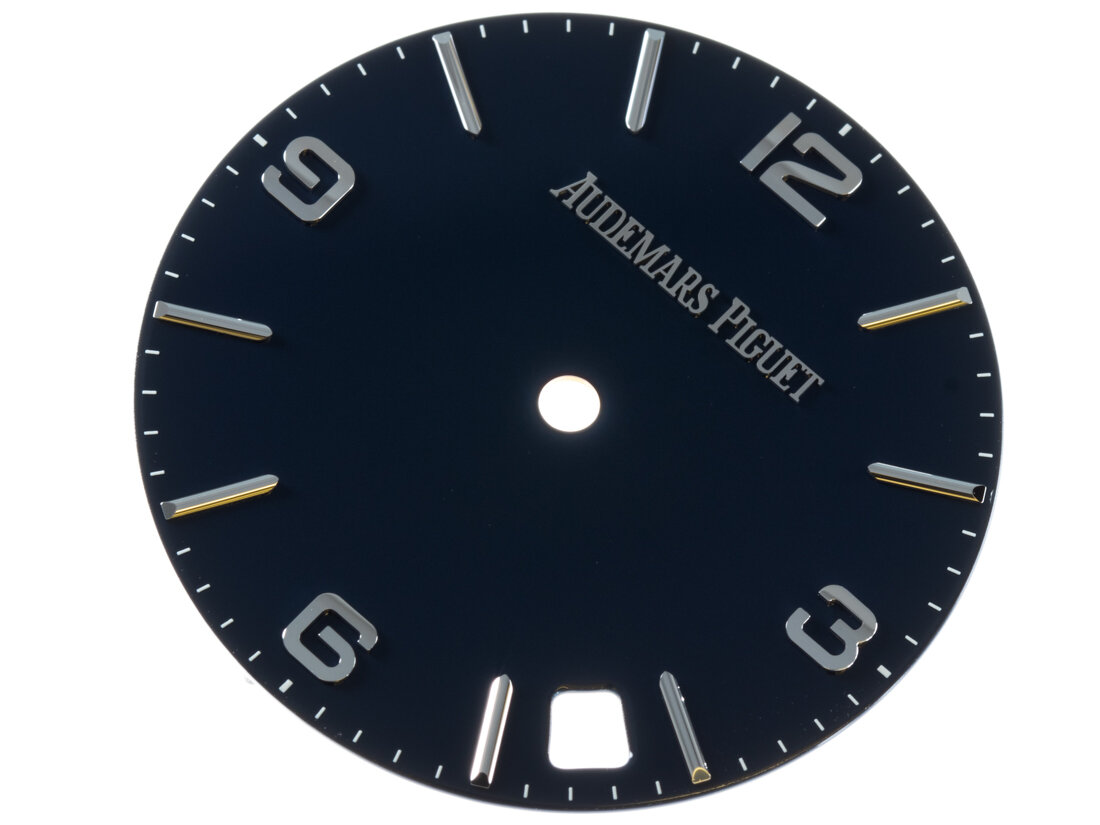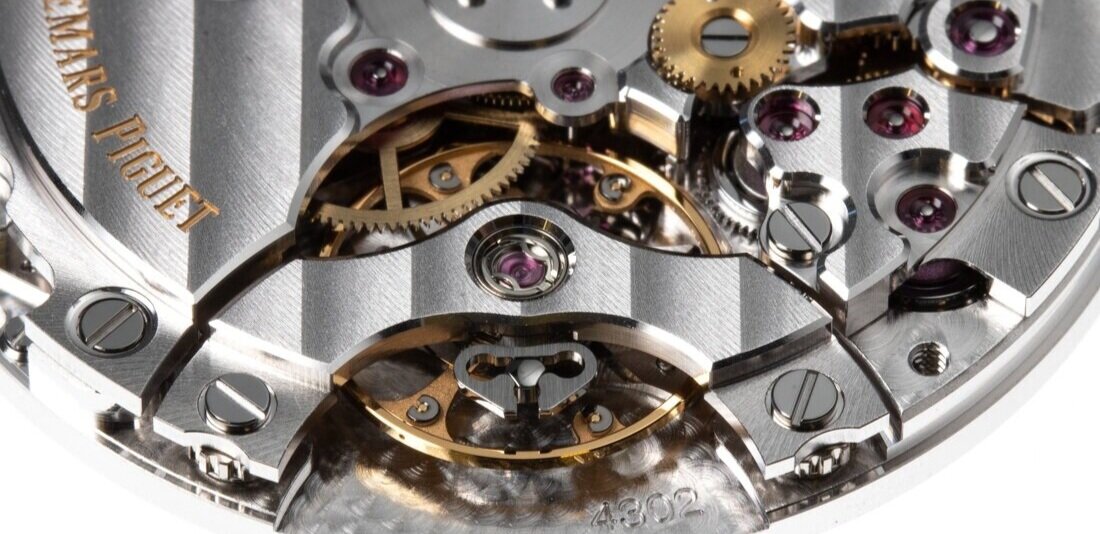The Reason
The first simple timepiece from the new collection of watches, Code 11.59 by Audemars Piguet to carry their newly developed calibre 4302.
Functions
Automatic winding, hour, minute, seconds and (instantaneous jumping) date indication.
At the top of the image on the case back surface are the hallmarks that include the carat of the gold, AU750 (18k), the makers stamp and the official stamps of the Swiss assay office.
Technical Specifications
Movement calibre 4302, thickness 4.8 mm, diameter 32 mm. Number of Jewels 32. Number of components 257. 22 carat gold rotor weight with bi-directional winding. Minimum power reserve 70 h. Frequency 4Hz, (28,800 VPH). Free sprung balance with inertia weights for regulation. The case is 18 carat white gold, 41 mm in diameter, 10.7 mm thick and water resistant to 3 atmospheres (30 m).
Please move the cursor across the image below, (or by finger on a smart phone), to rotate the watch.
Viewed face on, the case and shoulders are simple and classical in design. As the watch is tilted the shoulders are seen to be cut away to allow the central octagonal middle of the case to be accentuated. The recessed octagonal middle is sandwiched between the round bezel and the case back, all three parts are separate in the construction. The sapphire is more complex than conventional examples and although visibly round when viewed face on, the form is convex on the outside and concave on the interior, with a curve from 12 o'clock to 6 o’clock.
The winding crown has 8 facets associating to the octagonal form of the case centre
The curved sapphire viewed from the profile.
The large surfaces of the case are either circular or straight grained. All angles are polished. The large angles on the octagon middle case required that this section was separate from the bezel and case back (as well as the shoulders), to be able to polish them in order to accentuate the complex octagonal forms.
The case back is held in place by 5 screws. Each screw traverses the centre of the case and is fixed into the bezel. The bezel is initially held by 2 screws hidden under the case back, once the case back is in place all 7 screws hold the watch case assembly together.
The strap is held on a stainless steel bar with balance staff shaped pivots. These turn in the holes machined into the hexagonal headed shoulder screws. To remove the strap, both screws are unscrewed.
The shoulders are fixed onto the bezel. The lower section of the shoulder is a close fit to the case back when it is in place, close to the thickness of a sheet of paper between them. The strength of the design was observatory tested to guarantee the solidity of construction.
All of the edges around the shoulders are beveled and polished by hand.
There is no movement ring between the calibre and the inner case due to the calibre’s large diameter and the cases’s thick walls. The mass of the walls allow space for the various seals making the case water resistant and providing space for the case screws.
Most surfaces, seen and unseen are decorated.
Audemars Piguet movement calibre 4302
The dial removed from the movement. All of the batons/indexes and numbers are made in gold, polished and riveted in place.
The black surface of the dial is the result of a minimum of seven layers of lacquer, varying depending on colour and batch.
The gold brand name is made in two pieces and riveted in place. The process of development for it, took in excess of a year to perfect.
The rotor weight removed, showing the full view of the calibre bridges. The small yellow wheel to the left of centre, is the first to be driven by the rotor weight pinion, leading to the automatic winding train.
The brand name is machine engraved, plated and then filled in with a special lacquer prior to the following decoration, to protect it from being rhodium plated. Once the rhodium plating is done the lacquer is removed and the contrast between the red Audemars Piguet name and the silver surface finish is produced.
The 22 carat red gold rotor.
The ball race contains ceramic beads/balls that don’t require lubrication and run more smoothly and quietly than traditional steel versions.
The engraving on the gold rotor associates to the coats of arms of the two families. Audemars on the left with a dove, three silver stars and a flag posed on a tower. Piguet on the right with three stars and a rearing horse facing a lance. The coats of arms are positioned left to right to associate with the names.
The balance bridge holds the balance assembly between it and the mainplate, pivoting in Incabloc shock protection.
The balance spring is held in the triangular shaped polished steel stud that is in turn held in place on the balance bridge by the friction of the double sided thumb spring stud holder. The length of the material around the ‘thumbs’ allows for the elasticity needed to assure the steel stud is held tightly in place, but be adjusted by the watchmaker who regulates the watch. This assembly can rotate slightly to adjust the balance wheel in beat with the Swiss anchor.
The two bridges at 7 and 8 o’clock hold in place the automatic train, at 5 o’clock is the barrel housing the mainspring held under the barrel bridge.
On top of the barrel is the ratchet wheel seen through the cut-outs in the barrel bridge. In the left hand cut out the ratchet wheel meshes with the last wheel in the automatic winding train. On its right it meshes with the manual winding mechanism. The visibility made by these cutouts facilitates the assembly process for the watchmaker.
‘Captive barrels’, those where the ratchet wheel is held under the barrel bridge, traditionally wear less than those where the pivot traverses the bridge and a ratchet wheel sits above it.
The traditional Geneva stripes decoration cross the surface of the movement. All of the polished angling are produced by diamond cutters and with the Geneva stripes are rhodium plated once finished.
Recto-verso of the balance bridge with free-sprung balance wheel. 6 maslots/inertia blocks are adjusted for regulation.
A free-sprung balance does not have an index adjusting the effective length of the balance spring for regulation purposes. This improves the overall isochronism of the watch.
The balance and its bridge removed showing the Swiss anchor and its bridge in place.
The nuts that are screwed to the pillars upon which the balance bridge sits, can be adjusted to easily alter the end shake of the balance staff, with out altering the position of the shock protection in the balance cock.
The Swiss anchor and its bridge removed.
The first automatic train bridge removed.
The second automatic train bridge removed.
The going train bridge removed.
The going train removed.
The going train bridge.
The barrel bridge removed, leaving in place the barrel, balance brake/hack and part of the going train.
Instead of a centre wheel and integrated pinion, the barrel drives the centre pinion which meshes with a large beryllium-copper wheel leading to the going train.
Recto-verso of the barrel bridge.
Construction and design is always important, but each following step is as relevant as the one it precedes. The clean production and silky machined finish of the under surfaces shown here, represent the level of attention to the components from the moment they leave the machine.
The movement dismantled from the going side.
The date disc is held in place by 3 plugs (shown at ‘20’) that allow the disc to be removed without dismantling the complete calendar mechanism.
The date disc removed leaving the calendar and setting mechanism in place.
The date disc, with internal teeth form cut to allow for minimum friction when the disc jumps and a solid ‘stop’ once indexed.
The cross formed cam is linked with the rapid date change and pushes the disc around when the stem is turned in the first pulled position of the winding crown.
The instantaneous date jumper system and rapid date change is predominately made in hardened and polished steel
The large yellow wheel left of centre drives the operating lever below it that moves the date disc. The operating lever is pushed passing the end finger piece which is integrated into it over the tooth of the date disc and then released pulling the date disc clockwise by 1 day.
The cover plates for the date and setting mechanism.
The small cross shaped cam drives the date disc when in manual rapid change mode.
The movement mostly dismantled with the exception of the setting mechanism and two of the calendar components.
During the process of manufacturing the watches there are tailor-made containers produced to store and transport the components. Special movement and case holders are routinely made to ensure the watches are easily and safely manipulated. Below are the boxes used to store and transport the lacquered dials. The containers are reused.
The box containing the dial with dial claw.
The inner dial claw allows the dial to be removed from its outer box by the central column. Then by pinching the two outer elliptical columns the dial is released.
Before the movement is cased, it is tested in a plastic container with a working dial and hands until it has passed the various imposed tests. The tests include the chronometry of the time-keeping, the functionality of the rapid date change, the automatic mechanism.
Prior to a definitive winding crown a working brass one is used.
The working rotor in tungsten is used to test the watch prior to casing. Then it is removed and replaced with the definitive 22 carat version once the movement is cased up.
Prior to the assembly of the rotors they are transported in tailored containers and the surface protected with a thick plastic coating to avoid any scratches.
The hands are stored in anti-acid paper cards until they’re assembled.
Summary
When first viewing the aesthetics of the watch face on, the immediate effect is of a simple and classical design. When the watch is tilted a very different effect is generated, principally from the curved sapphire, octagonal centre and milled out shoulders. The result is a contemporary design with a modern, technical construction. Simple elements such as the sapphire and the system for holding the strap in position have been re-invented. The watch is a combination of diverse elements, assembled congruently to make an original contemporary round time piece.
The calibre, follows the same philosophy as was adopted for the case, classic in function but updated in its conceptional approach. The calibre is larger in diameter than AP have conventionally used. Manufactured by the brand it is solid, accurate, aesthetically balanced and well thought through, as well as well finished.
To learn more about Audemars Piguet

























































